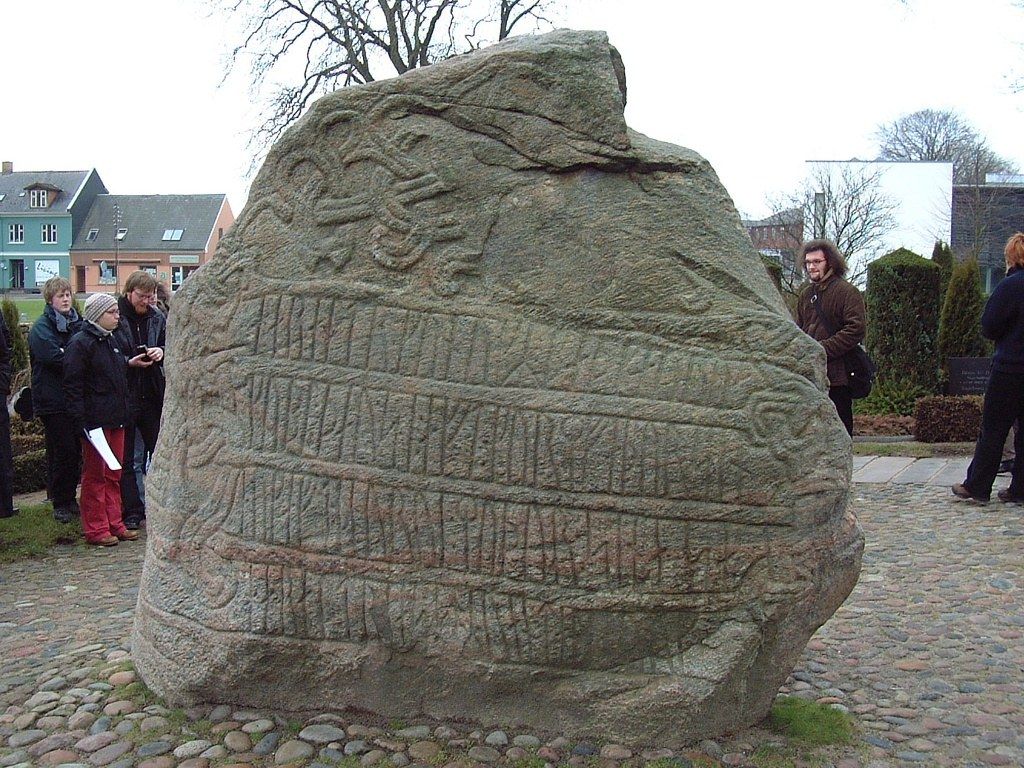King Gorm the Old and Queen Thyra, the parents of Harald Bluetooth, are widely credited with beginning the royal lineage of Denmark. Little is known for certain about the couple, but the impact of their reign is undeniable, as it helped the country to emerge from its Viking chieftain era as a Christian nation state with a bright future.
In ancient Denmark, a cluster of small provinces were ruled by belligerent tribal chiefs who proclaimed themselves as kings. It was not until the tenth century that these small provinces were united into one large kingdom by a famous chieftain known by the Danes as Gorm the Old (Gorm den Gamle).
Gorm: in like a storm
Gorm the Old, the Viking of Vikings, was the first historically recognised King of Denmark and ruled from 936 until his death in 958. Very little is known about Gorm – most of what we know is speculative. Many historians claim that he has one of the most misunderstood personalities in the history of Denmark, confused by many with his rabidly anti-Christian father. Citing his intolerant attitude towards Christianity, these historians overlook his enormous contributions towards uniting the smaller realms.
Gorm is believed to be the descendant of the Danish rulers of East Anglia in England, and one of his ancestors was named Guthrum, an English version of the name Gorm. A German medieval chronicler, Adam of Bremen, contended that Gorm was the son of the semi-legendary Danish king, Harthacnut of Northmannia (Northmen). Historians speculate that Adam could have either meant Norway, Normandy or even northern Jutland. Adam wrote that in around 916 or 917, Harthacnut invaded western Denmark and founded a kingdom within the realm of a young king named Sigtrygg Gnupasson.
Adam: good at chronicling, poor at geography
When he died of old age in around 947, his young son Gorm took over. According to Heimskringla, an old Norse kings’ saga by poet and historian Snorri Sturluson, Gorm then usurped part of Gnupasson’s dominion. However, Adam of Bremen claimed that the kingdom had been divided prior to Gorm’s ascension to the throne. Tenth century runestones in Jelling record that Gorm “won all of Denmark”, but it is believed that he probably only ruled Jutland from his capital in Jelling.
According to early sources, Gorm was open-minded, and this was reflected in his relationship with his Christian wife Thyra – to whom he dedicated the oldest of the Jelling Stones – and his Christian neighbours to the south of his kingdom.
Liked to spread it about
There is very little known about Thyra (even the information about her parentage is contradictory and chronologically doubtful) beyond her strong support of Christianity. She is credited with helping to spread it across Danish lands – territory that she also helped protect, overseeing the refortification of Danevirke.
This massive wall, which ran between the Schlei (a narrow inlet of the Baltic Sea) and the Treene river across what is now Schleswig, helped protect the kingdom from hostile southern neighbours, especially the Saxons. Started in 737, Thyra’s tenth century renovation added a ditch and earthen foundation capped by a timber stockade above it.
Playing hard to get
The historian Saxo Grammaticus, and also his contemporary Svend Aggesen, record how (with an element of fantasy, perhaps) Thyra ordered the construction after getting a year’s respite from the German emperor, Otto I, who was both a suitor and a threat to Denmark. With Gorm overseas on a military campaign that was to end in the disastrous battle of Louvaine, Otto came calling, only to be told by Thyra that she needed a year to give him an answer.
Gorm and Thyra had three sons: Toke, Knut and Harald, who later became known as King Harald Bluetooth, after whom today’s Bluetooth technology is named. Little is known of Toke, but Knut died at an early age, killed unjustly while watching a night game. Thyra saved most of her affections for Harald, who she brought up to be a Christian – a religion he would later enforce as the country’s official faith.
Bigger the mound, the bigger the mourning
According to runic inscriptions, Thyra is believed to have died when she was still young, some time before Gorm. She was buried at Jelling, and her burial mound was massive. On one of the stones there she is described as ‘tanmarkar’ – which historians claim means either the mother of Denmark, Denmark’s adornment, or Denmark’s salvation. The runestones also call her ‘Danebod’ – the pride of Denmark.
Gorm, meanwhile, died in 958 (according to studies of the timber used in his burial chamber). It is believed that he was initially buried in Thyra’s mound, but then later moved to the site of the first Christian church of Jelling by his son Harald Bluetooth.
















